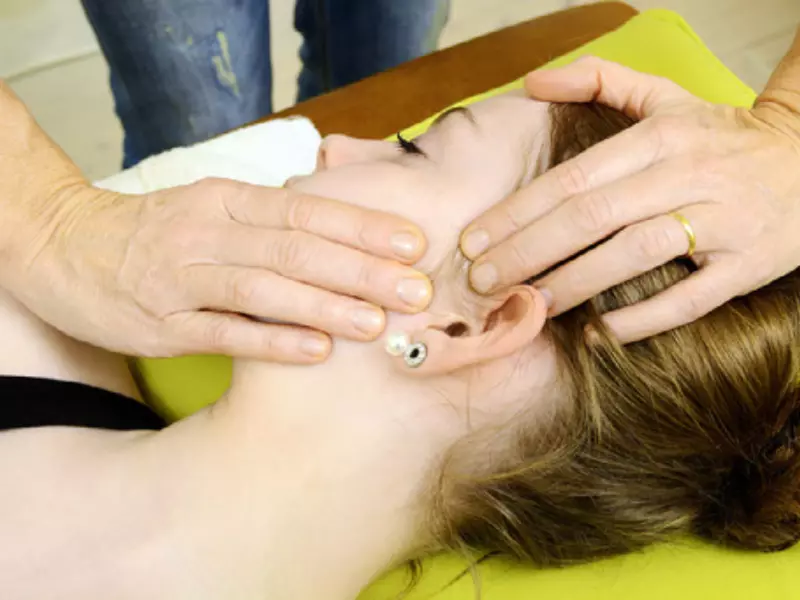Chiropractic Care for Jaw Pain, Dysfunction, and TMJ Disorders
If you’ve been dealing with jaw pain, clicking, tension, or even headaches and earaches, you might be struggling with TMJ dysfunction. TMJ disorders are very common. They affect an estimated 10 million people in the U.S. and can be frustrating, painful, and disruptive to daily life.
At Peak Spine and Wellness, we take a unique, structural approach to TMJ by not only addressing the jaw joint itself but also its relationship with the upper neck (cervical) spine and posture. Many people don’t realize that the alignment of your neck, especially your cervical curve, plays a huge role in the mechanics of the jaw. If your spine is out of alignment, your jaw often compensates and that can lead to chronic tension, dysfunction, or pain.
Recent studies have shown that chiropractic care can reduce TMJ pain and improve function by addressing these underlying structural imbalances. We use Chiropractic BioPhysics® (CBP) to analyze posture and spinal structure, combined with gentle, targeted techniques to restore jaw balance and function.
How Does the Jaw Work?
The temporomandibular joint (TMJ) is a hinge-like joint that connects your jawbone to your skull. You have one on each side of your face, and they work together every time you chew, speak, yawn, or swallow.
These joints rely on a complex interplay between bones, muscles, ligaments, and nerves. Proper function depends not just on the jaw, but also on the alignment of the skull, neck, and shoulders. Dysfunction in one area often creates a ripple effect of symptoms elsewhere.
What Is TMJ? Is It Common?
TMJ, or temporomandibular joint disorder, is a condition that affects the movement and function of the jaw or the hinging motion of the joint. It can include anything from clicking and popping to jaw locking or severe facial pain. TMJ disorders are more common than most people realize and often go undiagnosed for years because symptoms are so varied.
TMJ can affect adults and teens, and it often flares during periods of high stress or tension.
What Are the Symptoms?
TMJ symptoms can be sneaky and widespread. While we go deeper into symptoms
later in this page, common complaints include:
- Jaw clicking or popping
- Pain or tightness in the jaw, face, or neck
- Headaches or migraines
- Ear pain or pressure
- Ringing in the ears (tinnitus)
- Difficulty chewing or fully opening the mouth
- Locking of the jaw
Many people don’t realize that neck pain, poor posture, or even sleep issues can all be related to TMJ dysfunction.
What Are the Causes?
TMJ dysfunction can come from many different sources:
- Misalignment in the jaw or cervical spine
- Improper curve in the neck
- Poor posture or forward head posture
- Stress and jaw clenching or grinding (bruxism)
- Previous injuries to the face or neck
- Arthritis or joint degeneration
- Dental procedures or bite imbalances
Because the TMJ is such a complex joint, multiple factors usually contribute to dysfunction and it often requires a whole-body approach to correct it.
Why Is a Chiropractor Uniquely Positioned to Provide TMJ Relief?
Chiropractor, especially those trained in Chiropractic BioPhysics® (CBP), are uniquely equipped to assess and correct the relationship between the jaw and spine. Unlike a dentist who may only focus on bite alignment or an oral surgeon who might recommend surgery, we look at how your spinal structure, posture, and muscle tone are contributing to jaw stress.
When your cervical curve is misaligned or flattened, it changes the way your jaw hinges and moves. This can lead to overcompensation, muscle tension, and nerve irritation. By restoring proper alignment in the neck and improving overall posture, we can help relieve pressure on the jaw and support long-term healing.
Our care includes gentle jaw adjustments (when appropriate), muscle release techniques, postural correction, and spinal traction when needed. We work to restore natural, pain-free movement rather than just managing the symptoms.
$99 New Patient Special
Includes Consultation, Thorough Health History, Chiropractic Exam, Postural Analysis, X-rays if indicated, Report of Findings.
How Our Care Plan Works
1. Corrective
This initial stage focuses on addressing specific spinal misalignments and dysfunctions. Through targeted adjustments and specialized techniques, the goal is to restore proper alignment and function to the spine. This phase often involves intensive care to correct existing issues and alleviate pain.
2. Stabilization
The stabilization stage aims to reinforce the changes made. This involves strengthening surrounding muscles, improving posture, and ensuring that the spine maintains its proper alignment over time. Patients typically engage in exercises and receive ongoing adjustments to support long-term stability.
3. Wellness
The final stage emphasizes maintaining optimal spinal health and overall well-being. Wellness care involves regular check-ups and adjustments to prevent future issues and support a healthy lifestyle. This proactive approach helps patients maintain their progress, enhance quality of life, and promote overall health and wellness.
How We Treat TMJ Pain In Fargo, ND
Comprehensive Consultation and Exam
Our process begins with a detailed consultation and exam to truly understand the root of your symptoms. We take time to hear your history, ask about your lifestyle and stress levels, and evaluate your posture, jaw movement, and spinal alignment.
We perform a full thorough chiropractic exam, which may include digital x-rays if indicated, a postural analysis, and specific TMJ movement assessments. This helps us determine whether your TMJ issues are coming from the joint itself, the surrounding muscles, your cervical spine, or often, a combination of all three. Getting to the root cause is essential because otherwise, symptoms may just keep coming back.

Specific Chiropractic Care in Fargo, ND
A subluxation is a misalignment in the spine that interferes with the nervous system and limits the body’s ability to function at its best. If your jaw joint or any spinal joint is misaligned, the mechanics of how your jaw opens, closes, and moves can be affected.
TMJ can be more complex when both the jaw joint and (neck) cervical spine are involved. Our adjustments are extremely precise and aim to improve the alignment of both spine and jaw joints. This also allows your nervous system to function properly, muscle tone to normalize, and jaw motion to become smooth and pain-free. Compared to conventional treatment models that may rely on pain meds or bite guards, chiropractic care focuses on true correction and long-term results.
Soft Tissue Work
We often incorporate tissue work into our TMJ treatment plans. This helps address muscle tension, trigger points, and fascia restrictions that contribute to pain and dysfunction of the jaw.
Massage and muscle work complement chiropractic adjustments by relaxing overly tight areas, reducing inflammation, and improving blood flow to the affected tissues. Chiropractic and soft tissue work works together. The adjustment restores motion and alignment and the soft tissue work helps the body hold those changes more effectively.
Whether you’re dealing with mild jaw tension or debilitating TMJ dysfunction, we’re here to help. Our integrative, structural approach is designed to correct the root cause, restore natural function, and help you feel like yourself again.
Common Symptoms of TMJD in Fargo, ND
Jaw Pain
Why would the jaw be in pain?
Jaw pain is often caused by inflammation, muscle tension, or misalignment of the TMJ. When the joint isn’t moving properly, it creates pressure and stress on the surrounding tissues, leading to pain.
Is this pain associated with any other types of pain?
Yes. TMJ-related pain is often linked to neck pain, headaches, earaches, or facial tension. That’s because the muscles and nerves involved in jaw function overlap with those in the head and neck region.
What are the possible causes of jaw pain?
Misalignment of the jaw or cervical spine, chronic clenching or grinding (bruxism), stress, and previous trauma are common causes. It can also stem from poor posture or arthritis in the joint.
What is the best course of action to relieve jaw pain?
Addressing the root cause through chiropractic care, postural correction, soft tissue therapy, and at-home exercises provides the most effective and long-lasting relief. Pain relievers or mouthguards may help temporarily, but structural correction is key.

Jaw Popping and Clicking
Why does the jaw click?
Clicking or popping usually happens when the disc inside the TMJ becomes displaced or the jaw is misaligned. The joint doesn’t track smoothly, causing an audible or pop you feel when opening or closing the mouth.
When would one hear this clicking? Or do they just feel it?
It often occurs during chewing, talking, yawning, or opening the mouth wide. Some people hear it, others just feel the shift.
What is the best treatment to relieve jaw clicking?
Correcting misalignments in both the jaw and cervical spine, along with muscle release therapy and exercises to retrain movement, can help reduce or eliminate clicking over time.
Jaw Locking
How does the jaw lock?
Jaw locking happens when the TMJ becomes stuck or misaligned to the point that opening or closing the mouth becomes limited or impossible. This is often due to disc displacement or severe muscle spasms.
What does Lockjaw feel like?
It can feel like your jaw is stuck, tight, or frozen in place and will sometimes be accompanied by sharp pain or discomfort. It can last for a few seconds or become a chronic issue.
How can a chiropractor help unlock the jaw?
We assess the alignment and function of both the jaw and spine, then we will use gentle adjustments and muscle release techniques to restore proper motion and reduce joint tension. Correcting posture also prevents future locking episodes.
Jaw Clenching
Why would someone clench their jaw?
Jaw clenching is often a subconscious response to stress, poor posture, or misalignments in the spine. It can also happen during sleep or periods of intense focus.
What is the result of habitual jaw clenching?
It leads to muscle fatigue, inflammation, jaw pain, headaches, and sometimes tooth damage or sensitivity.
Are there other conditions that can arise from jaw clenching?
Yes, chronic clenching can contribute to TMJD, tension headaches, sleep disturbances, and neck pain. Over time, it may even affect facial symmetry.
What are the best solutions to relieve this tension?
Chiropractic adjustments, stress management techniques, posture correction, and soft tissue therapy are all effective. In some cases, nighttime mouthguards may be recommended to protect the teeth.
Difficulty Chewing
How does TMJ make it difficult to chew?
TMJ dysfunction can limit the jaw’s range of motion or cause pain when opening and closing the mouth. Muscle tension or joint misalignments can make it hard for the jaw to move smoothly and powerfully.
How does difficulty chewing affect a person’s life?
It can impact nutrition, social interactions, and overall quality of life. Many people avoid certain foods or feel self-conscious about eating in public.
What can you do to help improve a person’s ability to chew?
When we restore proper jaw alignment, it helps reduce muscle tension and improve movement of the jaw. Over time, chewing becomes easier, more comfortable, and pain-free.
Check Out Our Location Near You
3260 Veterans Blvd Suite 105, Fargo, ND 58104
Frequently Asked Questions About TMJ Treatment
Can chiropractic in Fargo, ND help with TMJ?
Yes. At Peak Spine and Wellness, we help patients with TMJ by addressing the root causes like misalignments in the cervical spine, postural distortions, and muscle imbalances. Our CBP approach restores function, reduce pain, and improve jaw mobility.
How do you permanently fix TMJ?
Permanent results come from addressing the underlying cause, not just masking symptoms. We use chiropractic adjustments, spinal curve correction, soft tissue therapy, and exercises to correct imbalances and support long-term healing.
What causes TMJ to flare up?
Stress, poor posture, clenching or grinding teeth, jaw misalignments, and neck issues can all trigger TMJ flare-ups. Even poor sleep or extended screen time can be contributing factors.
Can chiropractors crack jaws?
While some gentle jaw adjustments may be performed, the goal is never to “crack” the jaw. We focus on restoring alignment and mobility through precise, gentle and non-invasive techniques.
What happens if TMJ is left untreated?
Untreated TMJ can lead to chronic pain, worsening joint dysfunction, headaches, limited jaw movement, and even changes in bite or facial structure. It’s best to address it early.
How do you get rid of TMJ fast?
While quick relief is possible through adjustments and muscle work, long-term improvement comes from correcting posture, reducing stress, and following a customized care plan.
Can you fix TMJ without surgery?
Yes. The vast majority of TMJ cases do not require surgery. Conservative care including: chiropractic, muscle therapy, and corrective exercises can provide significant relief and improvement. Which ultimately leads to long lasting results.
Is TMJ a medical or dental problem?
It’s both. TMJ can stem from dental issues like bite misalignment, but also from structural and neurological issues involving the spine. Chiropractors look at the full picture to address the root cause.
What is a chiropractic adjustment for TMJ like in Fargo, ND?
Our adjustments for TMJ are gentle and specific. A TMJ-focused chiropractic adjustment involves precise corrections to the upper cervical spine and when necessary, the jaw joint itself. Typically, patients will feel some relief after an adjustment.
Can TMJ cause neurological problems?
Yes. TMJ dysfunction can affect the trigeminal nerve and surrounding structures, leading to symptoms like facial pain, numbness, headaches, and dizziness. That’s why it’s important to address it early with structural care.
At Peak Spine + Wellness we believe in empowering our patients to reach their peak potential! We offer chiropractic treatment for temporomandibular joint disorder or TMJ pain. Additionally, we offer wellness plans for those looking to reach peak potential while continuing to remain healthy once their problem is corrected. Get started with us today!
$99 New Patient Special
Includes Consultation, Thorough Health History, Chiropractic Exam, Postural Analysis, X-rays if indicated, Report of Findings.


